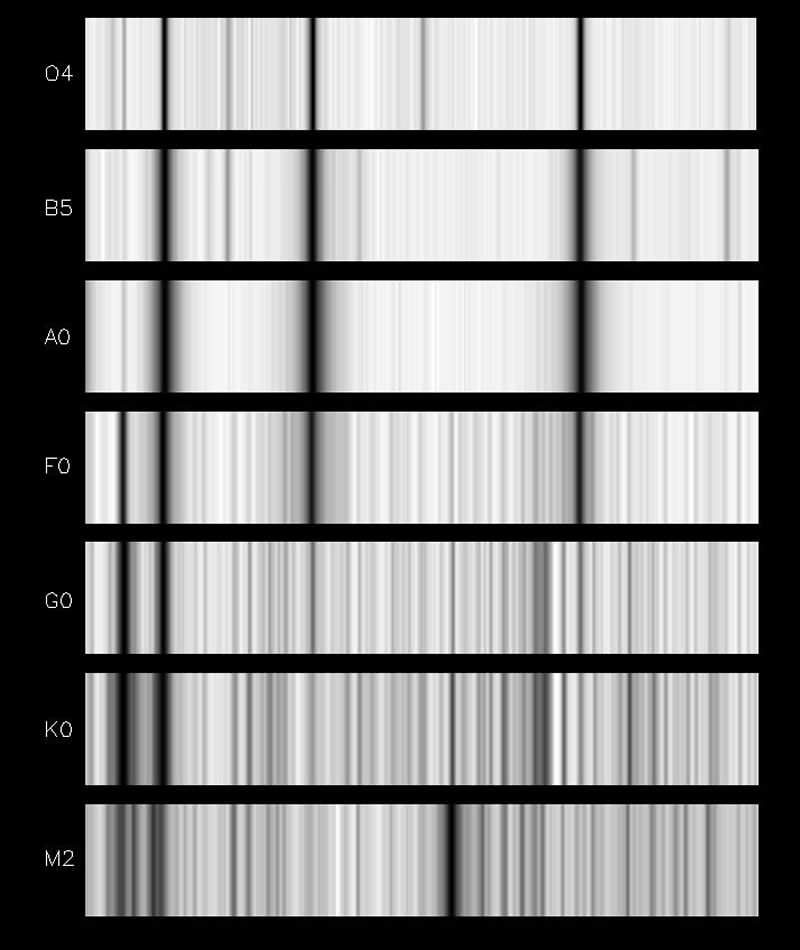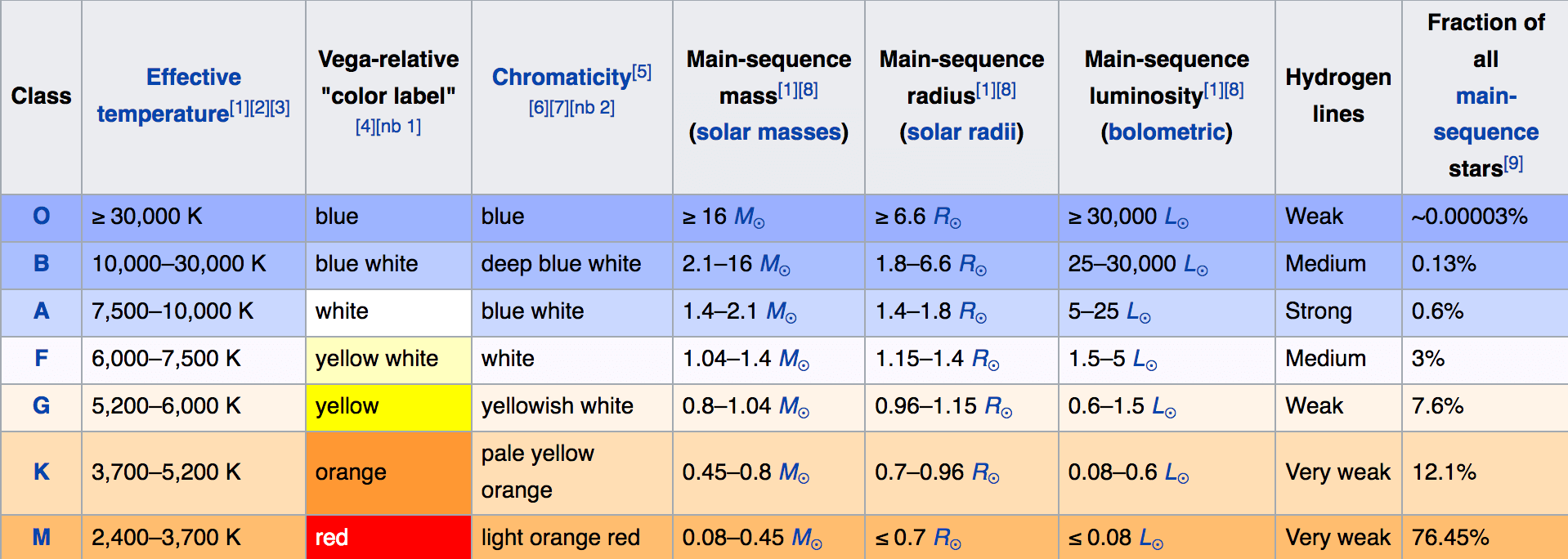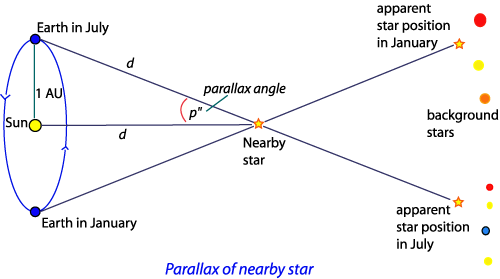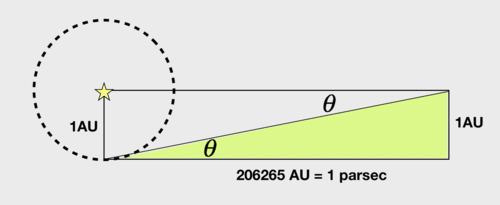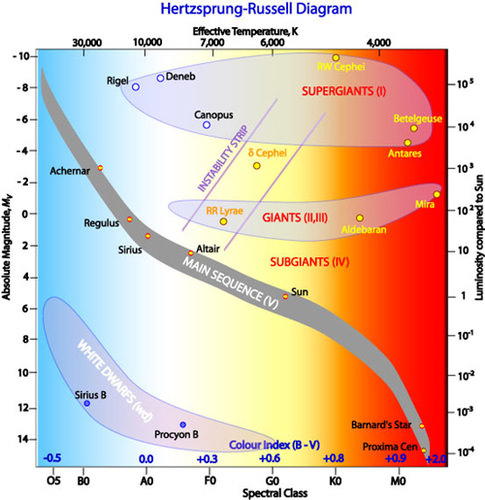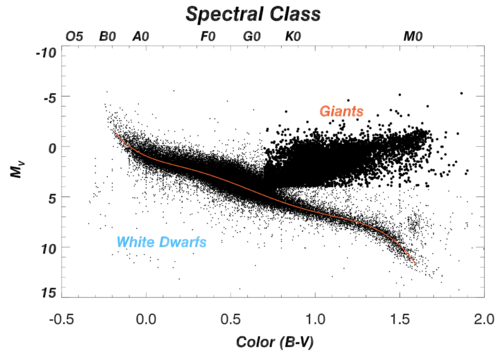3.1 恒星类型
章节大纲
-
S pectral Types
::频谱类型The mass of a star determines its temperature, how long it will live , and what atomic elements can be manufactured through fusion reactions. Stellar mass is one of the most fundamental attributes of a star. Unfortunately , stellar masses are notoriously difficult to measure .
::恒星的质量决定着恒星的温度、寿命、原子元素可以通过核聚变反应制造。 斯特拉尔质量是恒星最基本的属性之一。 不幸的是,恒星质量很难测量。Instead of stellar mass, brightness and color are the first two measurements that astronomers made of stars. The color of a star can be determined by measuring the brightness through two filters, typically, a blue and a red filter. Color is closely correlated with the temperature of the star. Red stars may be a relatively "cool" 3000K, while blue stars are much hotter: 10,000K or more.
::星体质量、亮度和颜色不是星体质量,而是由恒星制造的天文学家的前两个测量标准。恒星的颜色可以通过两个过滤器测量亮度来确定,通常是蓝色和红色过滤器。颜色与恒星的温度密切相关。红星可以是相对的“酷”3000K,而蓝色恒星则更热:1万K或更多。In 1850, Fraunhofer dispersed light from the Sun and observed characteristic absorption lines. A decade later, Kirchoff and Bunsen (famous for the Bunsen burner) realized that the dark lines in the spectrum were caused by absorption of light during specific energy transitions of atoms in the atmosphere of the Sun. When other stars were observed, they sometimes had different intensities or completely different absorption lines. The absorption lines in spectra provided a quantitative tool for classifying stars.
::1850年,Fraunhofer将太阳的光散开,观测到典型吸收线,十年后,Kirchoff和Bunsen(Bunsen燃烧器的名)认识到,光线中的暗线是太阳大气层原子特定能量转换时吸收光线造成的,观测到其他恒星时,它们有时有不同的强度或完全不同的吸收线,光谱中的吸收线提供了对恒星进行分类的定量工具。Spectra were originally recorded with photographic plates. This series of seven different types of spectra show characteristic patterns of dark lines, the signature of missing light at particular wavelengths where atoms like hydrogen in the atmosphere of the star absorb light. It is always true that the spectrum of a K0 or K1 star looks more like the spectrum here for a K0 star than the spectrum of the G0 or M2 star. Why do the spectra of stars vary?
::Spectra最初是用照相板记录的。 这一系列七种不同种类的光谱显示了暗线的特征模式, 即恒星吸收光的大气中原子如氢的某波长中缺少的光的特征。 K0 或 K1 恒星的频谱总是与 K0 恒星的频谱比 G0 或 M2 恒星的频谱看起来更像这里的频谱。 为什么恒星的光谱不同?The women computers
::妇女电脑In 1890, the Directory of the Harvard College Observatory, Edward Pickering, needed a workforce to analyze and catalog the extensive photographic data that had been collected. He employed dozens of women "computers" as his assistants. He believed that these women (unappealingly referred to as "Pickering's Harem") were ideal for the job because they did excellent work and they could be paid half the salary of men. Henrietta Swan Leavitt, who classified Cepheid variable stars, and Annie Jump Cannon were two of Pickering's women computers.The Director of the Harvard Observatory, Edward Pickering, obtained spectra for 10,000 stars. He and his staff grouped the spectra according to complexity with letters from A through Q (from the simplest looking to the most complex spectra). Director Pickering enlisted the help of Annie Jump Cannon, one of his "women computers." Cannon and Antonia Maury found a more natural ordering that merged the stellar types into the smooth continuous sequence shown in the spectral sequence . But it was not clear what this classification meant - what physical processes were driving the differences in the spectra?
::哈佛天文台台长爱德华·皮克林(Edward Pickering)获得了10,000颗恒星的光谱。他和他的工作人员根据从A到Q(从最简单的看到最复杂的光谱)的信件的复杂性对光谱进行了分组。皮克林主任得到了其“女性计算机”之一安妮·佩奇·坎农(Annie Jump Cannon)的帮助。坎农和安东妮娅·毛里发现一个更自然的指令,将星体类型合并到光谱序列所显示的平稳连续序列中。但不清楚这一分类意味着什么 — — 是什么物理过程驱动光谱中的差异?Annie Jump Cannon (1863 - 1941) was one of the "women computers" at Harvard Observatory. She developed a careful classification of stars with seven main groups: O, B, A, F, G, K, M. She was nearly deaf throughout her career. She was a suffragist and a member of the National Women's Party. In 1935, she created the Annie J. Cannon Prize for "the woman of any country, whose contributions to the science of astronomy are the most distinguished.
::Annie Jump Cannon(1863-1941年)是哈佛天文台的“女性计算机”之一,她对星体进行了仔细分类,分为七个主要组别:O、B、A、F、G、K、M.M.,她在整个职业生涯中几乎聋哑,她是窒息主义者,也是全国妇女党的成员。1935年,她为“任何国家的妇女,她对天文学的贡献最杰出”创建了Annie J. Cannon奖。expanded the catalog to include more than a million stars, and she developed a new system for spectral classification with seven main groups: O, B, A, F, G, K, M and three classes of peculiar stars. As you might imagine, the original classification of stars was in the form A, B, C... but it was later realized that the bins of stars needed to be shuffled to sort them by temperature, or equivalently color, to have a measurable parameter. Each spectral type is further subdivided from 0 to 9 (increasing numbers moving toward the next cooler spectral type). Our Sun is a G2 star.
::扩展目录以包括100多万颗恒星, 她开发了一个新的光谱分类系统, 共七大类: O、 B、 A、 F、 G、 K、 M 和 三类特殊恒星。 正如你可能想象的那样, 最初的恒星分类是表A、 B、 C... 但后来人们意识到, 恒星的文件夹需要按温度或等值颜色进行打乱, 才能有可测量的参数。 每个光谱类型进一步从 0 进一步细分为 9 个( 增加数量, 向下一个更冷的光谱类型移动 ) 。 我们的太阳是 G2 星 。
The following Table outlines the distinguishing characteristics of different spectral types of stars.
::下表列出了不同频谱类型恒星的特征。Characteristics of different spectral types for normal (hydrogen-burning) main sequence stars. Which stars have the shortest lifetimes? Which stars are most common? What is the spectral type of the Sun? How does the brightness of an O-type star compare to the brightness of an M-dwarf?
::普通( 氢燃烧) 主序列恒星不同频谱类型的特点。 哪些恒星寿命最短? 哪些恒星最常见? 太阳的光谱类型是什么? O型恒星的亮度如何与M型恒星的亮度相比?High mass stars are hotter and more luminous than low mass stars. You can see this from the data : the temperature of stars is directly tied to their color: higher mass, hot stars are blue while lower mass, cooler stars are red. The color differences are subtle, but can still be distinguished by eye when looking at stars in the night sky. The use of filters or spectroscopy allows the color differences to be easily quantified.
::高质量恒星比低质量恒星更热、更亮。 您可以从数据中看到这一点: 恒星的温度与它们的颜色直接相连: 更高质量、 热恒星是蓝色, 低质量是蓝色, 更冷的恒星是红色。 颜色差异是微妙的, 但是在看夜空中的恒星时, 仍然可以用眼睛来区分。 使用过滤器或光谱可以很容易地量化颜色差异 。The lifetime of the hydro gen-burning phase for a star depends on two factors: how much hydrogen exists and the rate of hydrogen fusion. For massive O-type stars, there is 100 times more hydrogen fuel than for stars like the Sun. However, the rate of fusion is so high that the O-type stars burn through this fuel in a million years. In comparison, stars like the Sun will burn hydrogen for about 10 billion years. And the lowest mass Mdwarf stars will burn hydrogen for more than 100 billion years (since the galaxy is only 13.7 Gyr old, there are no Mdwarf stars that have depleted all of their hydrogen).
::恒星氢燃烧阶段的寿命取决于两个因素:存在多少氢和氢聚变率。对于大规模O型恒星来说,氢燃料比太阳等恒星多100倍。然而,O型恒星的聚变率太高,以至于在一百万年中通过这种燃料燃烧。相比之下,太阳等恒星将燃烧氢约100亿年。而最低质量的Mdwarf恒星将燃烧氢超过1000亿年(因为银河系只有13.7千兆赫,没有Mdwarf恒星耗尽全部氢气)。Sometimes, stars form in instead of single stars. If we can map out the orbits of the stars, we can use the equation for gravitational force to derive their masses. For main sequence stars with measured masses, astronomers were able to derive a correlation between color (or equivalently temperature or spectral type) and stellar mass. Piecing together all of this information was a triumph that launched the field of astrophysics -- a study of the physical processes of stars.
::有时,恒星会形成而不是单一恒星。如果我们能够绘制恒星轨道图,我们可以使用引力方程式来获得它们的质量。对于测量质量的主要序列恒星,天文学家能够得出颜色(或相等的温度或光谱类型)和恒星质量之间的关联。所有这些信息结合在一起就是一种胜利,它开启了天体物理学领域 -- -- 对恒星物理过程的研究。Luminosity Class
::明度等级Stars have both a spectral type (OBAFGKM) and a luminosity class (I, II, III, IV, V). Spectral type is directly tied to the temperature (or equivalently, the color) of a star. The energy output of a star (luminosity) is directly tied to both temperature and size. Therefore, two stars can have the same temperature, but they can have different luminosities if their radii are different. The radius of a star is constant while it is burning hydrogen - this is the "main sequence" or luminosity class V for a star. When hydrogen is depleted from the core in a star that is similar in mass to the Sun, the core of the star collapses, but the outer envelope expands so that overall, the radius of the star increases. Now, the star evolves across the subgiant branch (luminosity class IV) and the surface temperature cools as the star expands. Even as the outer envelope of the star is increasing , the core of the star is collapsing; when the pressure is high enough in the core, helium fusion begins and the star enters the giant phase (luminosity class III). Stars that are more massive than the Sun will evolve from class V to giants (class III) or supergiants (class II or class I) depending on their mass.
::恒星既具有光谱类型( OBAFGKM ) , 也具有光度等级( I, II, III, IV, V) 。 光谱类型直接与恒星的温度( 或等量的颜色) 相关。 恒星的能量输出( 光度) 直接与温度和体积相关。 因此, 两个恒星的能量输出( 光度) 可以具有相同的温度, 但是如果它们的射线不同, 它们可以具有不同的光度。 恒星的半径在氢燃烧时是恒星的常态 - 这是恒星的“ 主要序列” 或光度等级V。 当恒星的核心从核心中耗尽时, 恒星的核心与太阳相似, 恒星的核心会破裂, 但外部信封会扩大, 使恒星的半径增加。 现在, 恒星的子分支( 光级 IV ) 和表面温度随着恒星的膨胀而变化。 即使恒星的外壳的外壳正在增加, 核心 ; 当恒星体压力在核心中足够高的时候, , 星级的高度将开始, 或巨级的星级 。
There are also subdwarfs (luminosity class VI) and white dwarfs (luminosity class VII) but by convention, those luminosity classes are not often used. Instead, those stars are usually just called "subdwarfs" or "white dwarfs."
::这些恒星通常被称作“子矮人 ” 或“白矮人 ” 。 这些恒星通常被称为“ 子矮人 ” 。 这些恒星通常被称为“ 子矮人 ” 。YouTube video: spectral classification
::YouTube视频:光谱分类Watch the video below to review star formation, spectral types, luminosity classes, and stellar evolution. What is the difference between stellar classes and luminosity classes (I, II, III, IV and V)? What is the spectral type and luminosity class of our Sun?Distances to the stars
::恒星距离In Chapter 1.1 "Pointing to the stars" we discussed the celestial coordinates of right ascension and declination. This coordinate system treated the sky as a two-dimensional projection on the celestial sphere. However, there is an additional coordinate: the distances to stars (very few stars are Cepheid variables).
::在“指向恒星”第1.1章中,我们讨论了右向升降和弯曲的天座坐标。这个坐标系统将天空作为天体上的二维投影处理。然而,还有一个坐标:与恒星的距离(很少有恒星是Cepheid变量 ) 。We need to know distances to stars to be able to derive the intrinsic luminosity of the star that is listed in above. Two stars with equal luminosity can have different apparent brightnesses because they are at different distances. Conversely, if we know the distance to a star, we can work backwards and calculate the intrinsic luminosity. Trigonometry is used to measure the distances to nearby stars. To understand how this works, hold up something like a pencil at a distance of just a few inches from your nose. Now, hold up another pencil at the greatest distance that you can reach (as demonstrated by , below ). If you wink your eyes (left then right), you'll see that the pencil that is closest to your face appears to have a much larger shift (right to left) than the distant pencil.
::我们需要了解恒星的距离,才能得出上面所列恒星的内在光度。 两颗光度相等的恒星的亮度可能不同,因为它们距离不同。 相反,如果我们知道恒星的距离,我们可以向后工作,计算内在光度。三角测量法用来测量离附近恒星的距离。要了解这一点如何起作用,将铅笔等东西挂在距离你鼻子几英寸的距离处。现在,举起另一根铅笔,在你能达到的最远处(从下面看 ) 。如果你眨下眼睛(从右转到右),你会看到最接近你脸上的铅笔似乎比远的铅笔有更大的变化(右向左转 ) 。Hold an object close to your face and a similar object farther away. When you wink your eyes from one side to the other, which of these two objects moves the most with respect to very distant objects?
::将一个物体贴近你的脸部,并将一个类似的物体拖得更远。当你眨眼睛从一边到另一边时,这两个物体中哪一个最偏移于非常遥远的物体呢?We use the same principle to measure distances to stars. Stars that are close to us will have larger parallaxes than more distant stars. Winking our eyes won't work for this measurement because the baseline (the distance between our eyes) is too small. Instead, we use the baseline of the Earth's orbit to see apparent position of the foreground stars jump relative to the background stars.
::我们用同样的原理来测量恒星的距离。 接近我们的恒星将拥有比远远恒星更大的parllaxes。 闪烁我们的双眼不会对测量工作起作用, 因为基线( 我们眼睛之间的距离)太小。 相反, 我们使用地球轨道的基线来观察地表恒星相对于背景恒星的表面跳动位置 。If we observe a star field in January and again in July, stars that are closer will appear to move with respect to background stars. This parallax effect allows us to determine the distance to nearby stars. Is the parallax angle larger or smaller for closer stars?
::如果我们在一月份和七月份观测一个恒星场, 距离较近的恒星似乎会相对于背景恒星而移动。 这个抛角效应让我们可以决定离附近恒星的距离。 对于较近的恒星来说, parllax 角度是大还是小?The illustrates the (very exaggerated) geometry for measuring the parallax (trigonometric distances) to stars. Notice the triangle subtended by the parallax angle (with vertices at the Sun, the Earth in July, and a nearby star). Because the distance to even nearby stars is so enormous, the parallax angle is tiny and the hypotenuse of this angle is essentially the same as the distance from the Sun to the star. This condition is called the small angle approximation. Sine and tangent functions can also be represented by expansions where the higher order terms drop out for small angles. When is a small angle:
::这些图解显示了测量对流星( 高度夸大) 和 恒星之间的对角( 矩形距离) 。 注意三角形以对流角( 以太阳为顶部, 7月的地球和附近的恒星为基点 ) 为基点 。 由于离附近恒星的距离如此之大, parlax 角度很小, 而这个角度的下限与从太阳到恒星的距离基本相同 。 这个条件被称为小角近距离 。 Sine 和 正切函数也可以以扩展为代表, 因为在扩展时, 小角的顺序条件会下降 。 当 ° 是一个小角度时 :
::来来来来去去去去去去去去去去去去去去去去去去去去去去去去去去去去去去去去去去去去去去去去去The baseline for this measurement is always 1 AU. However, the parallax angle measured by our telescope and the distance to various stars will be different.
::这一测量的基准始终是1AU,然而,我们的望远镜测量的准角和与不同恒星的距离将有所不同。[Eqn 1]
::[项目1]is the parallax angle in units of arcseconds (identified as "p'' in the above) and d is the distance from the Earth Sun to the star in units of parsecs.
::是弧秒单位(在上述单位中称为“p”)中的准角, d是从太阳从地球到恒星的距离,在分析单位中为恒星的距离。What is a parsec?
::什么是剖析?By definition:
::根据定义:.
::3602拉迪亚人。So 1 radian = 57.2959 degrees = 3437.75 arcminutes = 206265 arcseconds.
::1弧度=57.2959度=3437.75弧分钟=206265弧秒。For convenience, a new unit called a "parsec'' was defined such that 1 parsec = 206265 AU and subtends the physical length of 1 AU with an angle of one arcsecond (1") as shown in the below.
::为了方便起见,界定了一个称为“分离”的新单位,即1个剖析=206265AU,以1个AU的角为1弧秒(1个),将1个AU的物理长度从1弧秒(1个)小于206265AU,如下文所示。One parsec is defined to be 206265 AU and is the distance such that 1 AU is subtended by 1 arcsecond. Why did astronomers invent the unit of parsec? (Hint: what convenient feature is it based on?)
::一种分析被定义为206265AU,其距离是1AU由1弧秒的辅助。 为什么天文学家发明了分析单位? (提示:它基于什么方便特征? )[Eqn 2]
::1AU206265AU = 1AU1parsec [Eqn 2]Parallaxes have been measured for millions of stars using space missions like Hipparcos . If you need to know the distance to a star and the parallax for that star has been measured, then equation 2 is what you need. What is a parsec in other units?
::使用像 Hipparcos 这样的空间任务测量了数百万颗恒星的帕拉克斯。 如果您需要知道恒星的距离, 并且该恒星的参数已经测量, 那么方程式 2 就是您需要的。 其他单位的剖析是什么 ?[Eqn 3]
::1帕塞克=206265AU=3x1013千兆米=3.26In equation 3, 3.26 light years is the distance that light travels in 3.26 years. A light year may sound like a measure of time, but it is a distance. To instill a little awe, light could travel a distance equivalent to 7 times around the equator of the Earth in just one second. A light second is an incredible distance. A light year is conceptually almost impossible to grasp.
::在方程3中,3.26光年是光在3.26年中行走的距离。光年可能听起来像时间的量度,但是一个距离。为了保持一点点的恐惧,光可以在短短的一秒钟内绕地球赤道行走7倍的距离。光秒是惊人的距离。光年在概念上几乎无法把握。Apparent and Absolute Magnitudes
::显性与绝对磁度Astronomers classify the brightness of stars with a . This system dates back to the Greek scientist Hipparchus, who called the brightest stars "first magnitude" stars. The faintest type of stars that Hipparchus could see were "sixth magnitude" stars. Unfortunately for astronomy students today, this scale was based on the sensitivity of the human eye. It turns out that a 6 th magnitude star is 100 times fainter than a 1 st magnitude star. Another way of saying this is that a of 5 magnitudes corresponds to a brightness difference of 100 (or of 1 corresponds to a brightness difference of 2.512). You also need to remember that brighter stars have smaller magnitudes.
::天文学家将恒星的亮度分类为 。 这个系统可以追溯到希腊科学家希帕丘斯, 他称最亮的恒星为“ 一级” 恒星。 希帕丘斯可以看到的最微弱的恒星类型是“ 六级” 恒星。 不幸的是, 今天的天文学学生, 这个比例是以人类眼睛的敏感度为基础的。 结果发现, 第6级恒星比第1级恒星低100倍。 另一种说法是, 5级的值相当于100级的亮度差异( 或1级的值相当于2.512的亮度差异)。 您还需要记住, 更亮的恒星的亮度比1级小100倍。The apparent magnitude, m, tells us how bright an object appears to be. The apparent magnitude is the quantity that an astronomer can easily measure with a telescope. However, two objects may have the same intrinsic brightness (luminosity), but one star may appear to be fainter than the other because it is farther away.
::表面的星度 m 告诉我们一个天体看起来有多亮。 表面的星度是天文学家可以用望远镜轻松测量的数量。 但是, 两个天体的内在亮度( 光度) 可能是一样的, 但一个恒星看起来可能比另一个恒星的亮度要低, 因为它距离更远 。It is the absolute magnitude, M, that can compare the true brightness of stars. The absolute magnitude is the brightness that a star would be if it were located at a distance of 10 parsecs.
::M是绝对星级,它可以比较恒星的真正亮度。绝对星级是恒星如果位于10个剖面的距离上的亮度。[Eqn 4]
::M=m-5log(d10) [Eqn 4]where d is in parsecs. As a reality check, plug d=10 pc into equation 4. This says that the apparent magnitude is equal to the absolute magnitude at d=10 pc, s ince .
::d 在分析中。 作为现实检查, 将 d= 10 pc 插入方程式 4 。 这表示, 显然的数值等于 d= 10 pc 的绝对数值, 因为log10 (1)=0 。If d < 10 pc, then the absolute brightness must be dimmer than the apparent brightness (the star appears brighter because it is closer than 10 pc). If d > 10 pc then the absolute magnitude is brighter (smaller) than the apparent magnitude.
::如果 d < 10 pc, 那么绝对亮度必须比表面亮度更亮( 恒星看起来更亮, 因为接近 10 pc) 。 如果 d > 10 pc, 那么绝对亮度比表面亮度更亮( 较小) 。Like luminosity (the energy that a star emits), the absolute magnitude is a measure of the true intrinsic brightness and can be used to compare one star to another. By definition, the effect of distance has been eliminated (all stars are conceptually at 10 parsecs). The trick is to figure out what the luminosity or the absolute magnitude is... because all stars are not lined up at a distance of 10 parsecs. Thanks to trigonometric parallaxes, the distances to nearby stars is the easier parameter to measure. We can then solve for the absolute magnitude (or luminosity).
::像光度(恒星发出的能量)一样,绝对值是真实内在亮度的量度,可以用来比较一颗恒星和另一个恒星。根据定义,距离的效果已经消除(所有恒星在概念上都是在10个剖面上 ) 。 关键在于弄清楚光度或绝对值是什么...因为所有恒星没有排在10个剖面的距离上。 由于三角对等副作用,与附近恒星的距离是比较容易测量的参数。 然后我们可以解决绝对值(或光度 ) 。Sorting the Stars: H-R Diagrams
::星体排序: H- R 图表H umans like to sort and compare things because this helps us to make sense of our environment. After astronomers were able to determine distances and calculate the intrinsic brightness (absolute magnitudes) of stars, they were able to sort them in a meaningful way. The (H-R) diagram organizes different groups of stars. Cutting diagonally across the schematic H-R diagram are the "main sequence" stars. To anthropomorphize a bit, all of these stars are in their normal adult years, steadily burning hydrogen in their cores.
::人类喜欢对事物进行排序和比较, 因为这有助于我们理解我们的环境。 在天文学家能够确定距离和计算恒星的内在亮度( 绝对量) 之后, 他们能够以有意义的方式对恒星进行排序。 (H- R) 图表组织不同的恒星群。 在图示 H- R 图中截取对角是“ 基本序列” 的恒星。 人类形态化了一点, 所有这些恒星都在正常的成年年头, 都在核心中不断燃烧氢气 。The H-R diagram
::H- R 图表Locate the Sun on the H-R diagram. What is the absolute magnitude of the Sun? What is the spectral type and temperature?Schematic H-R diagram comparing stars of different spectral types and luminosity classes.
::对比不同频谱类型和发光等级的恒星的示意图H-R图。All of the known stars closer than 200 parsecs are shown in the below. The data for this plot were drawn from data cataloged from the Hipparcos satellite, which measured parallaxes (equivalently, distances) for 118,000 stars. Stellar distances and the measured apparent brightness at visible wavelengths, m V, were used to calculate the absolute magnitude of each star:
::所有接近200个剖面的已知恒星都显示在下面。此图的数据来自从测量118,000个恒星的等距(相等距离)的希帕科斯卫星上编目的数据。 用于计算每颗恒星的绝对值的斯特拉距离和可见波长( mV)测量的亮度( mV ) :[Eqn 5]
::d=1 parallaxMV=mV-5log10(d)+5[第5项]The added constant of +5 in Eqn 5 comes from applying one of the rules of logarithms to Eqn 4:
::Eqn 5 中加上的+5常数来自对 Eqn 4 适用对数规则之一:
::log *(ab) =log *(a) -log* (b)Stars closer than 200 parsecs. Distances and apparent magnitudes were measured by the Hipparcos satellite. This population of stars shows a clear main sequence (luminosity class V) and a subgiant (IV) and giant (III) branches. There are a few white dwarfs, but why are there no class I or class II stars in this plot? How do you think the structure in this diagram would change if the y-axis was "apparent" magnitude instead of "absolute" magnitude?
::接近200个颗粒的恒星。 Hipparcos 卫星测量了距离和表面上的星等。 这个恒星群显示一个清晰的主要序列( 光学V级) 和一个子( IV) 和巨型( III) 分支 。 有几个白色矮星, 但为什么没有一级或二级恒星在这个图中? 如果 Y 轴是“ 明显” 的星等而不是“ 绝对” 的星等, 那么这个图的结构会如何改变 ?
